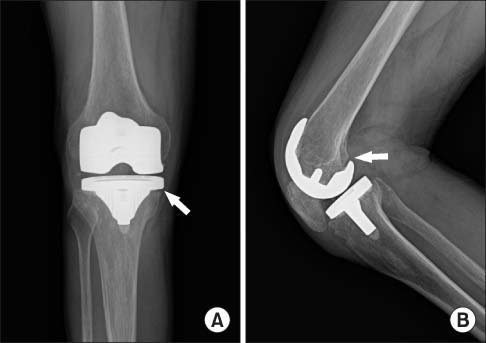J Korean Orthop Assoc.
2014 Oct;49(5):385-388. 10.4055/jkoa.2014.49.5.385.
Achromobacter xylosoxidans Infection Following Total Knee Arthroplasty
- Affiliations
-
- 1Department of Orthopaedic Surgery, Joint & Arthritis Research, Himchan Hospital, Seoul, Korea. changcape@naver.com
- 2Department of Internal Medicine, Joint & Arthritis Research, Himchan Hospital, Seoul, Korea.
- KMID: 2185175
- DOI: http://doi.org/10.4055/jkoa.2014.49.5.385
Abstract
- Achromobacter xylosoxidans is an opportunistic organism, mainly causing infection in immune compromised hosts, such as patients on dialysis. However, review of the medical literature showed that few cases of A. xylosoxidans infections following total knee arthroplasty have been reported. This organism has not been reported in prosthetic joint infections of patients who are not immune compromised. Here, a case of periprosthetic infection with A. xylosoxidans following total knee arthroplasty in a man with no medical history of immune suppression is reported.
Figure
Reference
-
1. Yabuuchi E, Oyama A. Achromobacter xylosoxidans n. sp. from human ear discharge. Jpn J Microbiol. 1971; 15:477–481.2. Coenye T, Vancanneyt M, Falsen E, Swings J, Vandamme P. Achromobacter insolitus sp. nov. and Achromobacter spanius sp. nov., from human clinical samples. Int J Syst Evol Microbiol. 2003; 53:1819–1824.
Article3. Reverdy ME, Freney J, Fleurette J, et al. Nosocomial colonization and infection by Achromobacter xylosoxidans. J Clin Microbiol. 1984; 19:140–143.
Article4. Taylor P, Fischbein L. Prosthetic knee infection due to Achromobacter xylosoxidans. J Rheumatol. 1992; 19:992–993.5. Ramos JM, Domine M, Ponte MC, Soriano F. Bacteremia caused by Alcaligenes (Achromobacter) xylosoxidans Description of 3 cases and review of the literature. Enferm Infecc Microbiol Clin. 1996; 14:436–440.6. Schäfer P, Fink B, Sandow D, Margull A, Berger I, Frommelt L. Prolonged bacterial culture to identify late periprosthetic joint infection: a promising strategy. Clin Infect Dis. 2008; 47:1403–1409.
Article7. Gales AC, Jones RN, Andrade SS, Sader HS. Antimicrobial susceptibility patterns of unusual nonfermentative gram-negative bacilli isolated from Latin America: report from the SENTRY Antimicrobial Surveillance Program (1997-2002). Mem Inst Oswaldo Cruz. 2005; 100:571–577.
Article8. Frommelt L. Principles of systemic antimicrobial therapy in foreign material associated infection in bone tissue, with special focus on periprosthetic infection. Injury. 2006; 37:Suppl 2. S87–S94.
Article
- Full Text Links
- Actions
-
Cited
- CITED
-
- Close
- Share
- Similar articles
-
- Achromobacter xylosoxidans Bacteremia in a Child with Neutropenia
- A case of scalp abscess caused by Achromobacter xylosoxidans after vacuum delivery
- A Case of Peritonitis Due to Achromobacter xylosoxidans subsp. xylosoxidans in a Patient Undergoing Continuous Ambulatory Peritoneal Dialysis (CAPD)
- VIM-2 Type Metallo-beta-lactamase Producing Achromobacter xylosoxidans subsp. xylosoxidans Isolated from Urine Specimens
- A Case of Chronic Dacryocystitis Caused by Achromobacter Xylosoxidans


